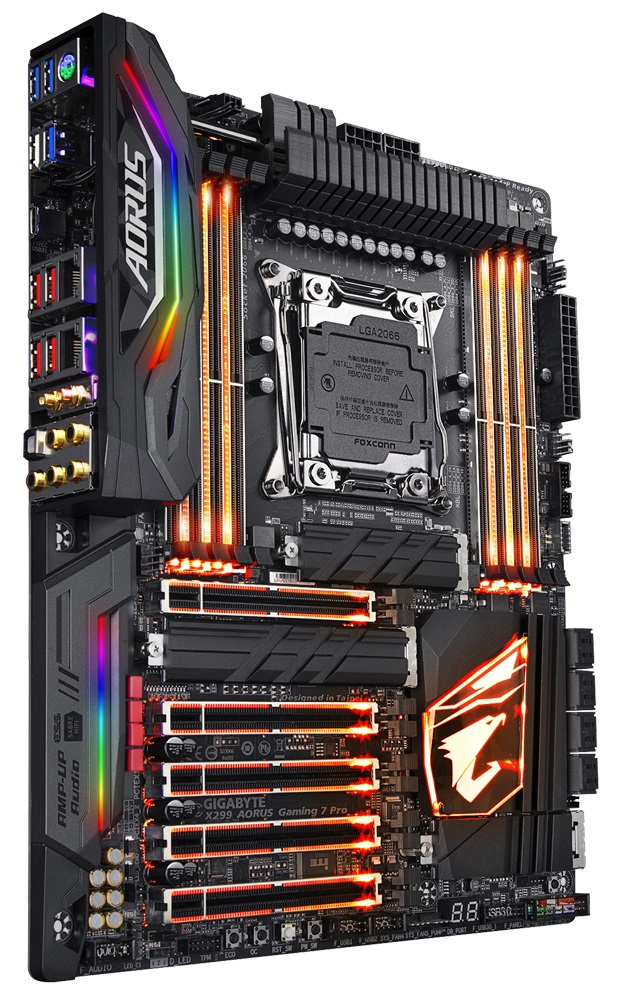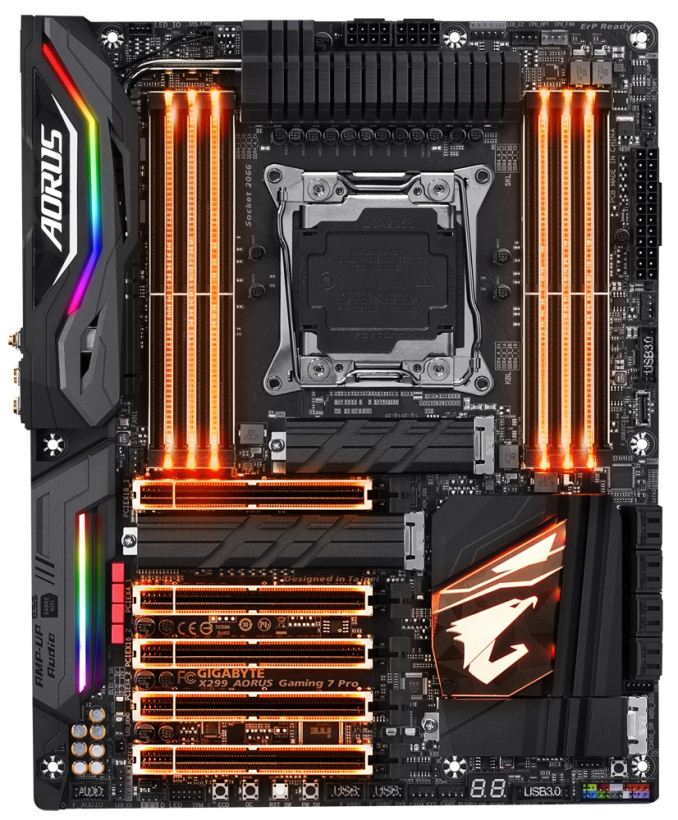It's An RGB Disco: The GIGABYTE X299 Gaming 7 Pro Motherboard, Reviewed
by Joe Shields on January 26, 2018 8:00 AM EST- Posted in
- Motherboards
- Gaming
- Intel
- Gigabyte
- AORUS
- RGB
- X299
- Basin Falls
- Skylake-X
- Gaming 7 Pro
Conclusion
The $400+ predicted price of the AORUS X299 Gaming 7 Pro gives it direct competitors by both price and function with boards like the MSI X299 XPower Gaming AC ($440), the ASUS ROG Rampage VI Apex ($430), and the ASRock Fatal1ty X299 Professional Gaming i9 XE ($423).
The AORUS line of motherboards purports to be its premium gaming line and many of the boards do appear to be just that, including the Gaming 7 Pro. Unlike the ROG lineup which starts well over $300, the AORUS X299 line had a bit more range on the low end, and starts around $210 with the X299 AORUS Gaming. At that price point it loses the expansive RGB LEDs and a few features, but, its also priced a lot lower than a comparable board. Most of the X299 AORUS lineup applies RGB LEDs in a seemingly carefree fashion: there are lights on the shrouds, PCIe slots, and chipset. But the AORUS boards take it a step further and add strips between each of the DIMM slots. There are those who love the look and control over the lighting, and those that do not. If the features tickle your fancy but the lights are a turn-off, consider shutting them off. To me, it is a love/hate arrangement. Outside of that, it does have a large two-part heatsink to cool the 12-phase VRM - it even has a small fan hidden away under the back panel shroud to help with cooling. It was able to maintain temperatures well within specifications in our test environment - even while overclocking.
Feature-wise, the board has a lot going for it. The 12-phase power delivery and heatsink arrangement handled the test system both stock and overclocked without so much as batting an eye, even at 4.7 GHz with the new CPU, and the internal fan was barely noticable on the testbed. The Gaming Pro 7 also keeps all three of the M.2 slots under heatsinks. While other boards do have similar features, not all implementations are the same. Either not all three are heatsinked or the heatsinks are thin and flimsy looking. If having a lot of high-speed USB ports are a priority, the Gaming 7 Pro is a good motherboard to look at without using an add-in card. The five USB 3.1 10 Gbps ports on the back panel is the only in X299.
The App Center software was a good place to access all programs from GIGABTYE. The few I used including Easy Tune (for monitoring, fan control, overclocking), RGB Fusion, and the Gigabyte HW OC App, worked without issue in my limited testing time. Along those lines, performance while overclocking was not really able to be compared as this is the first use of the retail CPU. That said, this board was able to take that CPU to 4.7 GHz in our testing. The dual heatsinks managed to keep the VRM at 65C during extended OCCT testing which is one of the cooler temperatures we have seen and well within specifications. Overall it is a capable overclocker.
Performance on the AORUS X299 Gaming 7 Pro was overall good with the vast majority of the results falling in the middle of the pack with the other boards. This tells us the board is using Intel's specifications and is boosting to 3.6 GHz on all cores. Where the board really shined was in the boot times, leading all motherboards by a small margin. Auto overclocking set all cores to 4 GHz, but also implemented a -3 AVX offset. So while non-AVX loads yielded improvements due to the 400 MHz clock speed increase, AVX loads only improved to the tune of 100 MHz.
As is the case, the difference comes down to features and what a user wants and needs in a given budget. At an expected price of $400+, the ASRock Fatal1ty Professional Gaming i9 XE sits squarely in the crosshairs. Between the two, the difference really comes down to appearance, heatsinked M.2 ports, more USB 3.1 ports on the G7P, and 10GbE on the ASRock. Both use high-end audio, support 3-Way GPUs and do not include a U.2 port. There are other boards surrounding it with different feature sets as well, but for what is included on the board and looking right around it, users will have to really dig deep and see what features are wanted and needed at this price point.
Other AnandTech X299 Motherboard Reviews:
Prices checked Jan 25th
- The Intel Skylake-X Review: Core i9-7980XE and Core i9-7960X Tested
- The Intel Skylake-X Review: Core i9-7900X, i7-7820X and i7-7800X Tested
- The Intel Kaby Lake-X Review: Core i7-7740X and i5-7640X Tested
- Intel Announces Basin Falls: The New High-End Desktop Platform and X299 Chipset
- ($400) The ASRock X299E-ITX/ac Review [link]
- ($400) The GIGABYTE X299 Gaming 7 Pro Review (this review)
- ($390) The ASRock X299 Professional Gaming i9 Review [link]
- ($370) The ASUS Strix X299-XE Gaming Review [link]
- ($350) The MSI X299 Gaming Pro Carbon Review [link]
- ($340) The ASUS X299 TUF Mark 1 Review [link]
- ($290) The ASRock X299 Taichi Review [link]
- ($280) The MSI X299 Tomahawk Arctic Review [link]
- ($260) The MSI X299 SLI Plus Review [link]
- ($500) The GIGABYTE X299 Gaming 9 Review (planned)
- ($490) The ASUS Prime X299-Deluxe Review (testing)
- ($330) The EVGA X299 FTW-K Review (in editing)
- ($290) The EVGA X299 Micro Review (in editing)
- ($286) The MSI X299M Gaming Pro Carbon AC Review (testing)
- ($199) The ASRock X299 Extreme4 Review (testing)
- ($?) The EVGA X299 Dark (planned)












29 Comments
View All Comments
tech6 - Friday, January 26, 2018 - link
Welcome to another episode of Pimp my Mobo.I'm sure its a great board but that LED craze cannot end soon enough.
Manch - Friday, January 26, 2018 - link
Yeah, don't care for the RGB crap. I have an corsair keyboard that lights up red for when its dark. That's it.The board feature list is nice but id like to see a compare to the rest of the line up and its competitors.
Can yall add that Joe?
Joe Shields - Friday, January 26, 2018 - link
That is an incredible amount of data entry considering the sheer number of boards on the platform (over 50 IIRC). Between Newegg and the board partner's websites, who both offer 'compare' functionality, should show at least some of what you are looking for.Ian Cutress - Friday, January 26, 2018 - link
It gives me an idea for a project.WithoutWeakness - Tuesday, January 30, 2018 - link
I use the Bench all the time to compare GPUs, especially to get an idea of how high end cards from 3-4 generations ago stack up against newer mid-range cards. If you guys can build a comprehensive tool to narrow down motherboards based on features it would be great. Currently my go-to sites are Newegg and PCPartPicker but having another tool to compliment those would be awesome.Manch - Monday, January 29, 2018 - link
Fair enough. What about a cut down version of just its main competitors? Would that be a small enough list, or is the price point that crowded? You spend a good bit talking about picking a board based on features without making a recommendation so I think a comparo table would be helpful.justaviking - Friday, January 26, 2018 - link
Soon we will need a second power supply in our systems... one we can dedicate to all the LEDs that dazzle us.Beaver M. - Sunday, January 28, 2018 - link
Not to mention extra cooling, because that many LEDs also produce quite some heat.milkod2001 - Friday, January 26, 2018 - link
Yeah it is stupid indeed, you pay extra for something you never asked for. Fortunately you should be able to completely switch all LEDs off if desired.Cygni - Friday, January 26, 2018 - link
I, too, get mad about things that add next to no price to motherboards that I can just turn off and ignore.